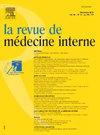L’hématopoïèse extramédullaire, une complication rare de la drépanocytose : à propos de six cas et revue de la littérature
IF 0.7
4区 医学
Q3 MEDICINE, GENERAL & INTERNAL
引用次数: 0
Abstract
Introduction
Extramedullary hematopoiesis (EMH) is very rarely described during sickle cell disease (SCD). Our aim was to describe six cases of EMH occurring in adult SCD patients and to conduct a literature review.
Methods
Retrospective, descriptive, and monocentric study, identifying all cases of EMH recorded in our cohort of adult SCD patients, up to April 2024. A literature review via PubMed included thirty-five articles (44 patients).
Results
Six patients (4 men, 83.3% with SS genotype [n = 5], 1 SC), with a median age of 22 (range 12–64) years at the time of EMH diagnosis were included. Four patients (66.7%) had an aseptic osteonecrosis of the hip. The localization of EMH varied: paravertebral (n = 3), peri-articular in the hip (n = 1), adrenal (n = 1), hepatic (n = 1), splenic (n = 1) and was similar to the localizations reported in the literature. EMH was symptomatic at diagnosis in half of the cases. The diagnosis was established by histology (n = 3/3) and/or typic magnetic resonance imaging (MRI) (n = 4/4). The median baseline hemoglobin was 9.1 (extremes 5.8–10.9) g/dL. A watch-and-wait approach was primarily observed.
Conclusion
EMH in SCD patients appears to be rare, with varied localizations. Its diagnosis is made with MRI and/or biopsy, and its treatment is not consensual.
髓外造血,镰状细胞病的罕见并发症:六例系列分析和文献复习。
简介:髓外造血(EMH)在镰状细胞病(SCD)中很少被描述。我们的目的是描述6例发生在成年SCD患者中的EMH,并进行文献综述。方法:回顾性、描述性和单中心研究,确定截至2024年4月我们的成年SCD患者队列中记录的所有EMH病例。PubMed的文献综述包括35篇文章(44名患者)。结果:6例患者(男性4例,83.3%为SS基因型[n=5], 1例SC), EMH诊断时中位年龄为22岁(12-64岁)。4例(66.7%)发生髋关节无菌性骨坏死。EMH的定位不同:椎旁(n=3),髋关节关节周围(n=1),肾上腺(n=1),肝脏(n=1),脾脏(n=1),与文献报道的定位相似。半数病例在诊断时有EMH症状。通过组织学(n=3/3)和/或典型磁共振成像(MRI) (n=4/4)进行诊断。中位基线血红蛋白为9.1 g/dL(极值为5.8-10.9)。观察和等待的方法是主要观察到的。结论:SCD患者的EMH罕见,且定位多样。它的诊断是通过MRI和/或活检,其治疗不是双方同意的。
本文章由计算机程序翻译,如有差异,请以英文原文为准。
求助全文
约1分钟内获得全文
求助全文
来源期刊

Revue De Medecine Interne
医学-医学:内科
CiteScore
0.70
自引率
11.10%
发文量
526
审稿时长
37 days
期刊介绍:
Official journal of the SNFMI, La revue de medecine interne is indexed in the most prestigious databases. It is the most efficient French language journal available for internal medicine specialists who want to expand their knowledge and skills beyond their own discipline. It is also the main French language international medium for French research works. The journal publishes each month editorials, original articles, review articles, short communications, etc. These articles address the fundamental and innumerable facets of internal medicine, spanning all medical specialties. Manuscripts may be submitted in French or in English.
La revue de medecine interne also includes additional issues publishing the proceedings of the two annual French meetings of internal medicine (June and December), as well as thematic issues.
 求助内容:
求助内容: 应助结果提醒方式:
应助结果提醒方式:


